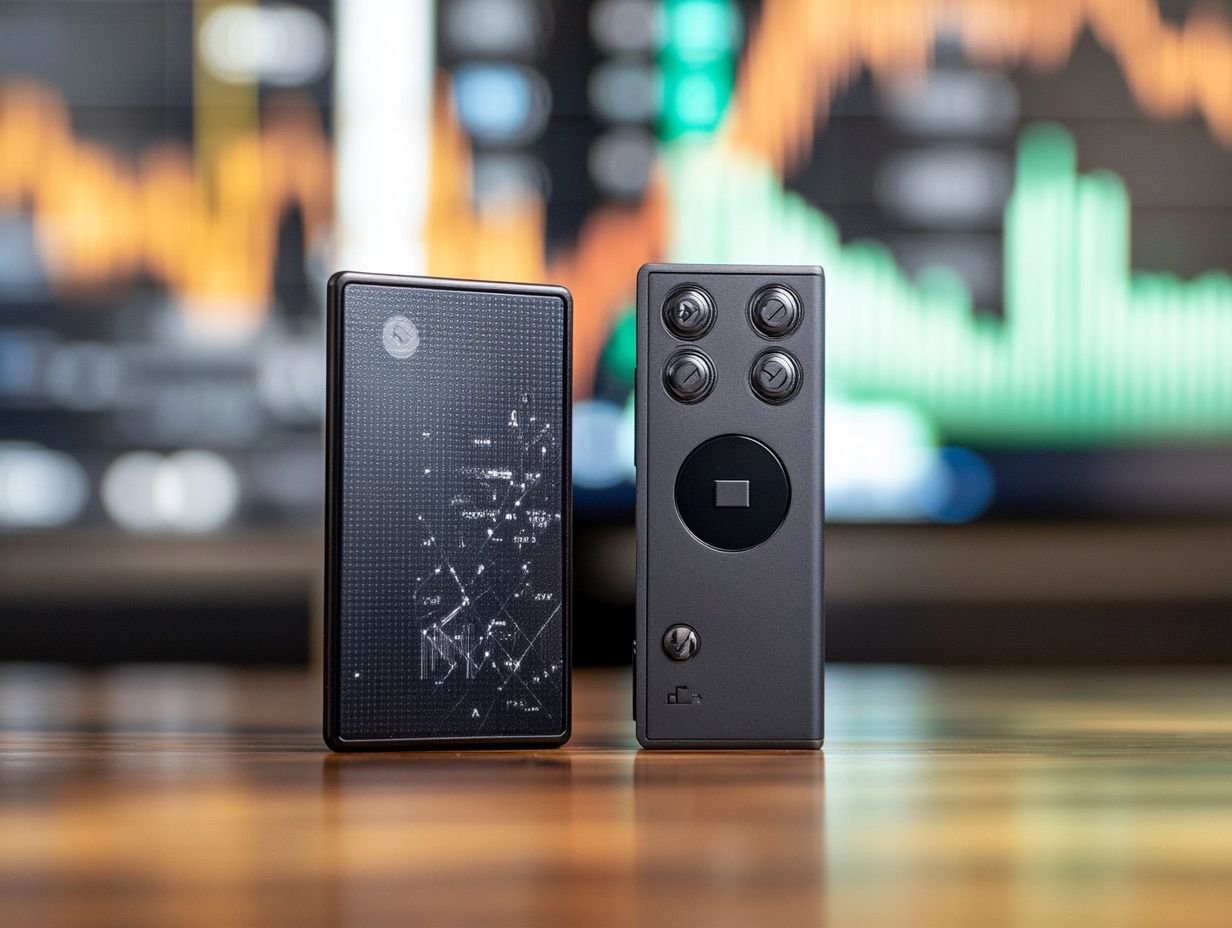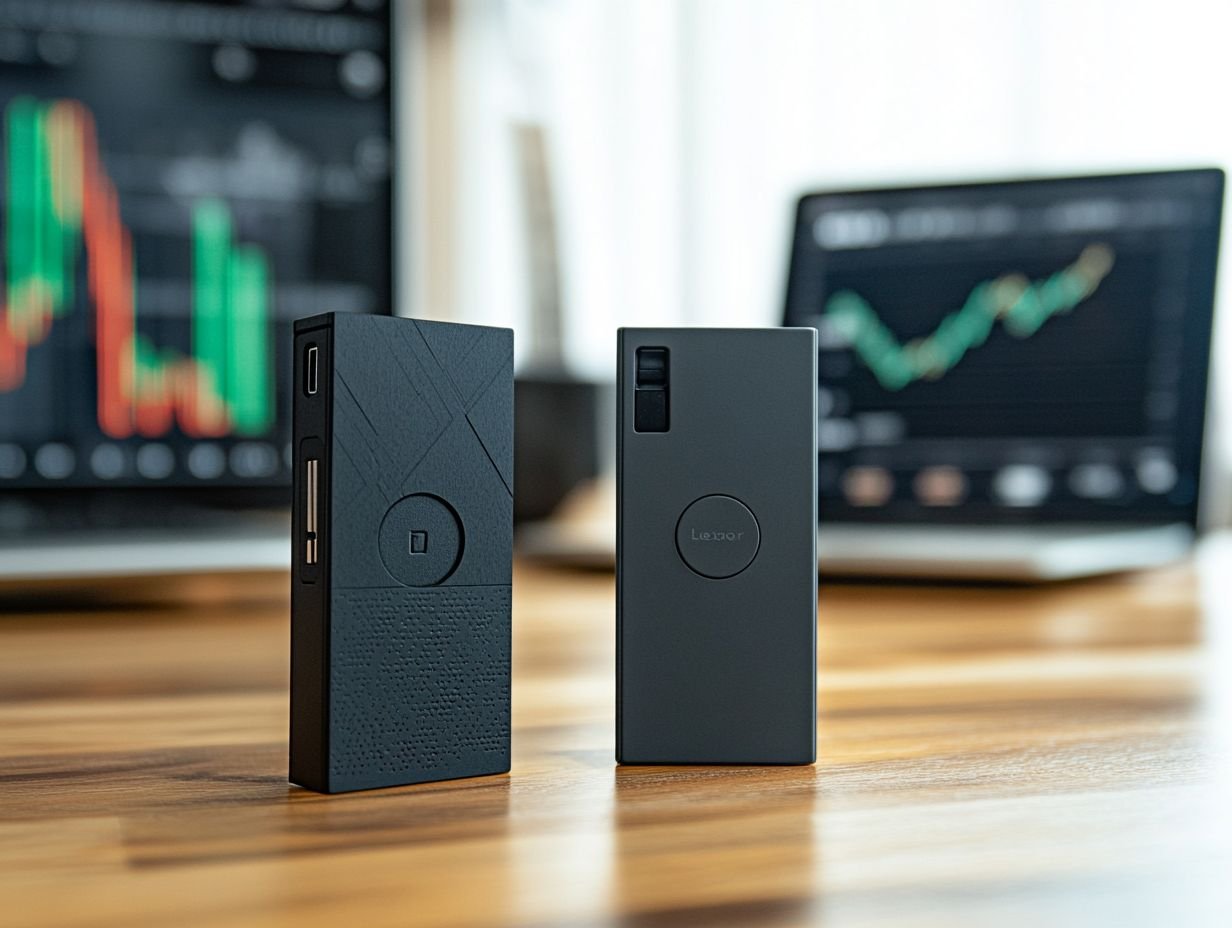Ledger vs. Trezor: Which Hardware Wallet is Best for You?
When it comes to securing your cryptocurrency holdings, choosing the right hardware wallet, whether Ledger or Trezor, is crucial.
Two of the most popular options, Ledger and Trezor, each offer unique features, security measures, mobile app integrations, and user experiences.
This comparison explores key aspects such as pricing, supported cryptocurrencies, advanced features, and ease of use, ensuring you have all the information needed to make an informed decision.
Whether you’re a beginner or a seasoned investor, find out which wallet fits your needs best.
Key Takeaways:

Ledger vs. Trezor – Side-by-Side Comparison
In the competitive realm of hardware wallets, Ledger and Trezor emerge as prominent contenders for the management of cryptocurrencies and the safeguarding of digital assets. A detailed side-by-side comparison of these two hardware wallets uncovers significant distinctions in their security features, supported digital assets, and user-friendly interfaces.
This analysis enables cryptocurrency investors to make well-informed decisions tailored to their individual needs.
Price Comparison
When selecting between Ledger and Trezor, it is crucial for crypto investors to grasp the price points of these hardware wallets, particularly for those in search of budget-friendly options that still deliver robust security features. A meticulous price comparison becomes invaluable in evaluating which wallet offers the best value for managing cryptocurrency holdings and understanding security vulnerabilities.
Both brands present a range of models tailored to diverse budgets and needs. Ledger features the Nano S, an economical entry-level option that provides essential security without straining one’s finances. Conversely, Trezor’s Model One, priced similarly, is designed for beginners and boasts a user-friendly interface.
For investors seeking advanced features, Ledger’s Nano X and Trezor Model T are available at a premium price but come equipped with Bluetooth connectivity and a touch screen, respectively. By examining these various tiers, investors can discern which wallet strikes the optimal balance between price and functionality, ensuring a sound investment in security and blockchain technology integration.
Unique Features of Ledger
Ledger offers a remarkable array of unique features that distinguish it from other hardware wallets, most notably through its Ledger Live application, which facilitates seamless management of cryptocurrency holdings and transactions. With capabilities such as Bluetooth connectivity, secure chip technology, cold storage for secure storage, and advanced functionalities for staking and NFT management, Ledger attracts a diverse range of crypto investors.
The Ledger Live app significantly enhances the user experience by providing an intuitive interface that allows individuals to effortlessly track their portfolios and execute trades directly, ensuring that investment monitoring is straightforward and efficient, integrating both software wallets and hardware devices.
Bluetooth capability affords a flexible and convenient connection to mobile devices, catering particularly to those who are frequently on the move, enhancing their experience with mobile app compatibility.
Additionally, the platform’s staking options enable users to earn rewards on their holdings without the hassle of switching between different platforms.
Incorporating integrated NFT management features, Ledger enables collectors to efficiently store, buy, and sell digital assets, positioning itself as not only a secure wallet but also a comprehensive solution for a variety of crypto needs and decentralized applications.
Unique Features of Trezor
“`html
Trezor stands out in the hardware wallet market with a suite of distinctive features, notably the Trezor Model T, which boasts a user-friendly interface complemented by an open-source software environment. With advanced functionalities such as Shamir Backup and comprehensive recovery options, Trezor is tailored for cryptocurrency investors who prioritise both security and user-friendliness. For a detailed comparison, check out Ledger vs. Trezor: Which Hardware Wallet is Best for You?.
“`
This intuitive design streamlines the process of managing multiple cryptocurrencies, making it easily navigable for both seasoned investors and newcomers to the crypto landscape. The open-source nature of Trezor fosters ongoing community engagement, ensuring that the software remains consistently updated with the latest security enhancements and features.
Its sophisticated backup solutions instil confidence, allowing users to create multiple secure backups to protect against potential loss or theft. These innovative elements coalesce to deliver a seamless experience, bolstering the security and functionality that cryptocurrency enthusiasts demand in their digital asset management.
Security Features: Ledger vs. Trezor
The security features of Ledger and Trezor play a crucial role in safeguarding digital assets, with each wallet employing distinct strategies to protect private keys, recovery phrases, and passphrase protection.
By examining their dual-layer security methods, secure element technology, and other essential security protocols, including recovery backup, users gain valuable insights into which wallet provides the most comprehensive protection for their investments.
Supported Cryptocurrencies

Both Ledger and Trezor provide robust support for a diverse range of cryptocurrencies; however, their respective lists of supported assets, including coin support and trading options, reveal significant differences that could influence a user’s choice.
Understanding the specific coins and tokens each hardware wallet supports—such as Bitcoin, Ethereum, and beyond—is crucial for proficient cryptocurrency management and integration options with crypto exchanges.
Ledger’s Supported Currencies
Ledger encompasses a broad spectrum of cryptocurrencies, including prominent assets such as Bitcoin and Ethereum, alongside a myriad of altcoins, establishing itself as a formidable option for cryptocurrency management. This extensive array of supported assets renders Ledger a favoured choice among investors seeking to diversify their portfolios. Additionally, Ledger Stax and Ledger Nano S Plus models further expand its appeal.
With offerings that span from Litecoin and Ripple to the latest tokens, users can effortlessly oversee a comprehensive portfolio within a single, secure platform. This versatility not only streamlines the tracking of various digital assets but also significantly enhances security and control over investments, minimizing risks related to security vulnerabilities.
By leveraging Ledger’s advanced technology, individuals can take comfort in the knowledge that their assets are protected against theft and fraud, enabling them to concentrate on strategic trading and long-term growth. For those embarking on their journey in the realm of digital currencies, this remarkable level of versatility proves invaluable, supported by market analysis tools and educational resources that instill confidence as they navigate the dynamic landscape of cryptocurrency.
Trezor’s Supported Currencies
Trezor offers robust support for a diverse array of cryptocurrencies, including prominent options like Bitcoin and Ethereum, while highlighting features such as NFT management and staking options that significantly enhance its appeal to crypto investors. This wide-ranging support positions Trezor as a formidable contender in the hardware wallet market, with models such as the Trezor One and Trezor Safe 3 further expanding its utility.
By accommodating a variety of altcoins, such as Litecoin and Cardano, the wallet enables users to effortlessly diversify their portfolios. The capacity to manage NFTs directly within the platform appeals to both seasoned traders and newcomers eager to navigate this burgeoning market. Additionally, the staking options enable investors to generate passive income on their holdings, all while securely storing their assets, with easy setup and recovery backup enhancing overall security.
These innovations reflect the dynamic landscape of digital assets, establishing Trezor not merely as a storage solution but as a comprehensive hub for contemporary crypto investment strategies. Additionally, with Trezor Safe 3 and Ledger Nano S Plus models, users have more affordable options to suit various needs.
User Interface and Experience
The user interface and overall experience of hardware wallets such as Ledger and Trezor are pivotal in determining the accessibility and functionality of cryptocurrency management for investors. A user-friendly interface, complemented by educational resources and mobile app compatibility, as well as desktop apps and browser extensions, can significantly elevate the experience of managing digital assets.
When evaluating these wallets, it is essential to consider the intuitiveness of their designs for both novice and experienced users. Ledger presents a sleek interface that simplifies setup and navigation, allowing users to effortlessly access their accounts and execute transactions. In contrast, Trezor’s mobile app compatibility and integration with FIDO2 and U2F for secure authentication enable users to manage their wallets on the go, streamlining operations for those who prefer the convenience of smartphones.
Both platforms offer a wealth of educational materials designed to guide users through various functionalities, ultimately fostering confidence in managing their investments, leveraging blockchain technology and decentralized applications.
Connectivity Options
When considering connectivity options, Ledger and Trezor present distinctive solutions that enhance the usability of their hardware wallets while ensuring secure storage of digital assets. Understanding these connectivity features, such as Bluetooth connectivity and integration options with digital currency platforms, is crucial for crypto investors aiming to integrate their wallets with mobile applications and other devices.
Both brands offer versatile interfaces that cater to varying user preferences. Ledger stands out with its Bluetooth connectivity, enabling users to manage their cryptocurrencies effortlessly through mobile applications, free from the inconvenience of wires. Additionally, it supports NFT management and secure storage of cryptocurrency holdings. Conversely, Trezor employs a robust USB interface, guaranteeing reliable connections and easy compatibility across a wide range of platforms, including decentralized applications and crypto exchanges.
These connectivity options not only streamline interactions with cryptocurrencies but also uphold the highest standards of security, including dual-layer security and passphrase protection, allowing individuals to transact with confidence while safeguarding their digital assets.
Ease of Use for Beginners
For beginners venturing into the realm of cryptocurrency, the user-friendly nature of hardware wallets like Ledger and Trezor is essential for a seamless introduction to crypto management. A straightforward interface, clear recovery phrase instructions, and readily available educational resources, such as investor guides, significantly enhance the onboarding experience for new users.
Both wallets emphasise simplicity, allowing those less familiar with technology to securely store their digital assets with ease. Ledger’s intuitive step-by-step guides and Trezor’s engaging tutorials effectively demystify the setup and management of cryptocurrencies, including Bitcoin and Ethereum.
Each platform proactively curates a wealth of instructional content tailored specifically for novice users, addressing critical topics such as seed phrase comprehension and wallet security best practices.
By providing these resources, they effectively lower the barriers to entry, enabling new users to embark on their cryptocurrency journeys with confidence and clarity.
Mobile Application Compatibility

Mobile application compatibility emerges as a crucial factor for contemporary crypto investors, with both Ledger and Trezor crafting solutions that elevate the management of digital assets while on the move. Ledger users benefit from Ledger Live, renowned for its market analysis tools and portfolio tracking tools, while Trezor offers dedicated applications, underscoring the significance of the mobile experience in comprehensive crypto management.
These applications enable users to effortlessly access their portfolios, enabling seamless transactions, staking options, and in-depth analytics. The user interface of Ledger Live is artfully designed with a clean, intuitive layout that guides users through each process, whereas Trezor’s apps feature a straightforward design that emphasises security and user-friendliness, including software wallets integration and NFT management.
Both solutions exhibit compatibility with a variety of mobile devices, ensuring that investors can manage their cryptocurrencies with efficiency, regardless of their location. Distinctive features, such as Ledger’s portfolio tracking tools and Trezor’s password manager, further enhance their allure, providing additional functionality that transcends conventional wallet management.
Final Verdict: Which Wallet is Right for You?
The choice between Ledger and Trezor as the ideal hardware wallet ultimately hinges on the unique needs and preferences of each individual crypto investor. By carefully weighing various factors—including price, distinctive features, security measures, cold storage capabilities, and overall usability—investors can reach a well-informed conclusion regarding the most suitable wallet.
Prioritisation is key; users must determine what aspects matter most to them, be it the wallet’s compatibility with a wide array of cryptocurrencies or the allure of a user-friendly interface. Ledger is often praised for its formidable security protocols, including the secure chip, and elegant design, while Trezor appeals to enthusiasts with its open-source platform, catering to those who highly value transparency and advanced features.
Despite the merits of both options, each comes with its own set of drawbacks, such as potential learning curves for those new to the realm of cryptocurrency. Additionally, Trezor’s Shamir Backup feature and Ledger’s Ledger Stax offer unique opportunities for secure recovery. Thus, by reflecting on their specific requirements and conducting thorough research, users can make a confident choice that aligns seamlessly with their investment strategy.
FAQs About Ledger and Trezor
In the dynamic world of cryptocurrency, prospective users frequently grapple with questions surrounding Ledger and Trezor, which are pivotal in guiding their choices. Key considerations often include security features, user-friendly interfaces, and the extent of cryptocurrency support.
This FAQ section seeks to elucidate common concerns and offer valuable insights into these esteemed hardware wallets.
1. What are the main differences between Ledger and Trezor?
The primary distinctions between Ledger and Trezor reside in their unique security features, such as Ledger’s secure element and Trezor’s open-source software, the range of supported cryptocurrencies, and the overall user experience, all of which significantly influence a crypto investor’s selection. By diving into these differences, individuals can more effectively align their wallet choices with their specific requirements.
In terms of security, Ledger employs a secure element chip that provides formidable protection against potential hacks, whereas Trezor emphasises open-source software, promoting transparency. This fundamental approach resonates with those who prioritise a robust security methodology.
The spectrum of supported cryptocurrencies also differs, with Ledger showcasing compatibility with a wider array of altcoins, including Ripple and Cardano, while Trezor remains steadfastly focused on established cryptocurrencies like Bitcoin and Ethereum.
User experience is another vital factor; Ledger’s interface may present a steeper learning curve, appealing to seasoned users, while Trezor is designed for simplicity, making it particularly suitable for newcomers.
Grasping these nuances is essential for making well-informed decisions in the crypto landscape.
2. Which wallet is safer: Ledger or Trezor?
Determining which wallet offers superior safety between Ledger and Trezor necessitates a thorough examination of their security features, specifically the technology employed to safeguard private keys and their cold storage capabilities. Each wallet presents its unique approach to protecting digital assets, making this a vital consideration for cryptocurrency investors looking for security vulnerabilities and mitigation strategies.
A closer look at the methodologies utilised by each brand reveals that both place a premium on user protection while navigating the intricate landscape of cryptocurrency storage. Ledger leverages a Secure Element chip, meticulously designed to withstand physical attacks, ensuring that private keys remain concealed from potential threats. In contrast, Trezor champions an open-source design, fostering community-driven audits and promoting transparency.
Moreover, both wallets provide robust cold storage solutions, effectively keeping assets offline and significantly reducing the risk of hacking attempts. Features like Ledger’s Secure Element chip and Trezor’s FIDO2 and U2F support further enhance security. By examining these features holistically, users can make informed choices about how to best protect their investments.
3. Which wallet is better for new users?
For newcomers entering the realm of cryptocurrency, the decision between Ledger and Trezor often hinges on their user-friendly interfaces and the educational resources they provide. These elements, including budget-friendly options like Ledger Nano S Plus and Trezor One, are crucial for facilitating a seamless onboarding experience for those just starting out.
A wallet that prioritises user-friendliness not only simplifies the management of cryptocurrencies but also alleviates the apprehension that often accompanies initial transactions. For beginners, access to comprehensive guides, tutorial videos, and responsive customer support can significantly enhance their learning journey, particularly with easy setup and recovery backup options.
As they explore features such as account setup, purchasing, and transferring digital assets, a wallet designed with intuitive usability in mind becomes essential.
Moreover, engaging actively with communities and forums offers newcomers valuable insights and tips, transforming the entire experience into something less intimidating and far more enjoyable, especially when dealing with trading options and coin support.
Frequently Asked Questions

1. What is the difference between Ledger and Trezor hardware wallets?
Ledger and Trezor are two of the most popular hardware wallets used for storing cryptocurrencies. The main difference between them lies in their design and security features. Ledger uses a custom operating system while Trezor uses an open-source one, making it more transparent. Additionally, Ledger supports more cryptocurrencies compared to Trezor.
2. Which hardware wallet offers better security?
Both Ledger and Trezor are highly secure hardware wallets that use advanced encryption and multi-factor authentication to protect your cryptocurrencies. However, Trezor has a unique feature called “Recovery Seed” and offers the Trezor Model T with Shamir Backup for added security. Ledger’s secure element chip further enhances security, making both options reliable.
3. Can I use Ledger and Trezor with any cryptocurrency?
Both wallets support a wide range of cryptocurrencies, including Bitcoin, Ethereum, and more. Ledger and Trezor regularly update their firmware to include new supported cryptocurrencies, ensuring broad cryptocurrency support.
Yes, both Ledger and Trezor support a wide range of cryptocurrencies, including Bitcoin, Ethereum, Litecoin, Ripple, and Cardano. However, Ledger supports more than 1,500 cryptocurrencies, making it the more versatile option for crypto investors with diverse portfolios and staking options.
4. Which hardware wallet has a better user interface and functionality?
Ledger and Trezor have different user interfaces, but both are designed for user-friendliness. Ledger has a sleek and modern interface with a larger screen, Bluetooth connectivity, and integration options with Ledger Live, making it easier to navigate and view your transactions. On the other hand, Trezor has a simpler interface and a smaller screen, but offers open-source software and passphrase protection, which some users may find beneficial for enhanced security.
5. Are there any differences in price and secure storage features between Ledger and Trezor?
The price of Ledger and Trezor hardware wallets can vary depending on the specific model and features. However, in general, Ledger tends to be more expensive than Trezor, with affordable options like the Trezor Safe 3 and Ledger Nano S Plus available. While both offer high-quality security features, such as a secure element and secure chip, Ledger’s larger screen, advanced features, and wider cryptocurrency support may be worth the extra cost for some users looking for more functionality.
6. Can I use both Ledger and Trezor hardware devices at the same time for secure storage?
Yes, you can use both Ledger and Trezor hardware wallets simultaneously if you have multiple cryptocurrency holdings. This can provide an extra layer of security, including dual-layer security and cold storage, and diversify your storage options. However, it is recommended to only use one hardware wallet as your main storage for easier crypto management, tracking of your assets, and utilizing features like recovery phrase and Shamir Backup.




